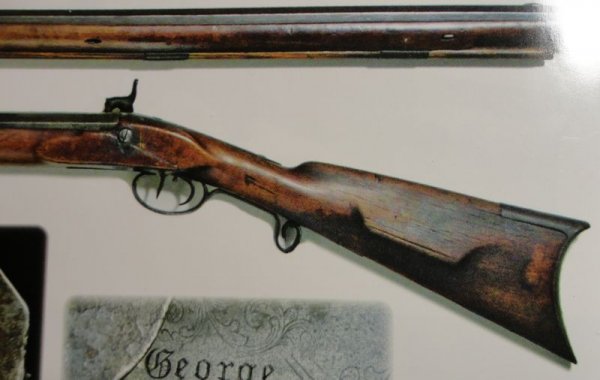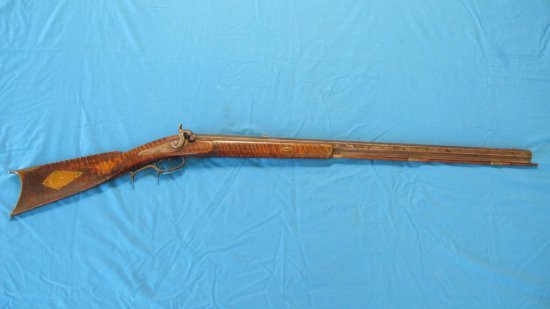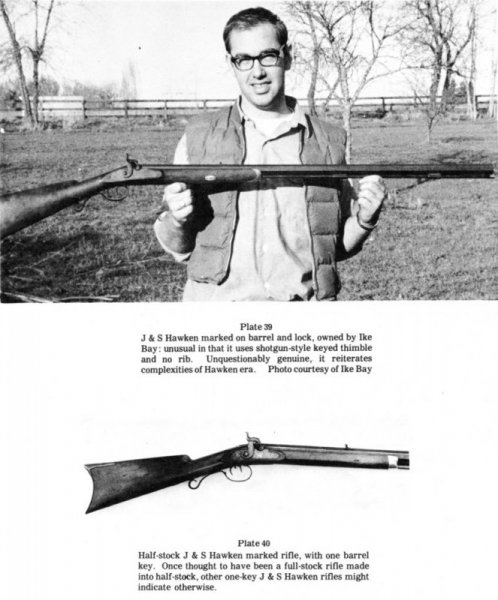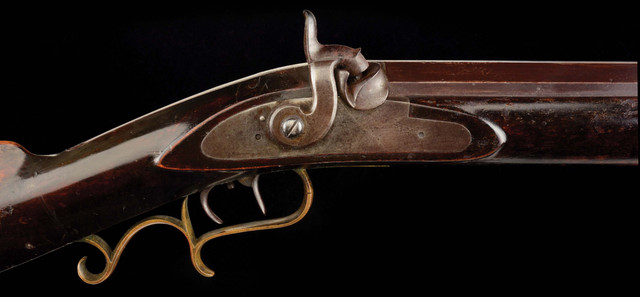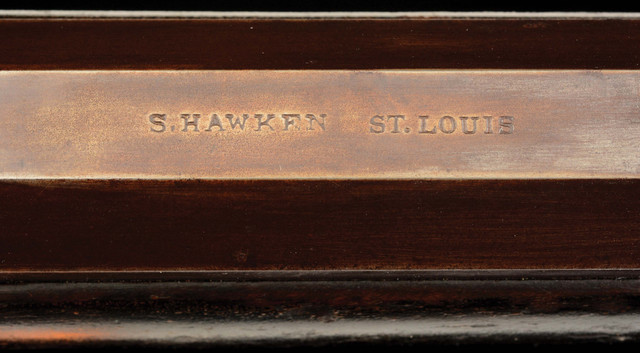Well, there has been a lot of criticism of guns that are supposed to be like the Hawken.. however to say that all Hawkens look like the first image is not exactly accurate. Here in first image is one 'Hawken' copy as we usually expect. The other five [actually six .. two in last image] give us some reason to be a little less sure. They are certified, legitimate Hawken rifles.
Dale, there is a lot of variation in Hawken rifles. The brothers formed their partnership in 1825. Jacob died in 1849. Samuel continued to manage the shop until about 1855 when he semi-retired, though he apparently continued to build rifles part-time for a few more years. That's 30+ years of making rifles in St. Louis, so their rifles did change over time.
Your selection of 6/7 rifles isn't the best to demonstrate the variations in Hawken rifles, though. The fourth rifle is probably a fake. It sold at Rock Island Auction for only $4,313, which is well below market value for an authentic Hawken. The stamp on the barrel doesn't look right. The fifth rifle is questionable, too. Tristam Campbell and Christian Hoffman, who were employees and sometimes partners to the Hawkens, made rifles in the style of the Hawken brothers and often used back action locks. I know of no authentic S. Hawken rifle with a back action lock, though.
Excluding those two, the second rifle looks like a small caliber "sporting rifle" that was made for the local market. A number of these rifles survive.
The third rifle is generally accepted as a J&S Hawken full stock even though the barrel marking is illegible. Hawken full stock rifles are a little different than their half stock rifles. They didn't simply use the same pattern for the stock and extend the wood all the way to the muzzle. There are differences in full stock rifles made in the J&S period and full stock rifles made after Jacob died, too.
The last two rifles were a puzzle to John Baird. Both are marked J&S Hawken. I don't know anything more than what Baird wrote in the caption for the top rifle, but I saw the bottom rifle at the Colorado Gun Collectors Show a few years ago and got to examine it. It definitely was originally a full stock rifle and was cut back to half stock sometime during its working life.
But I do agree with you that it is wrong to think that all Hawken rifles looked like the Kit Carson Hawken and the Jim Bridger Hawken, which are the image that most people have when they think of a Hawken rifle.
The brothers made different "models":
- Early half stock large bore rifles
- Early full stock large bore rifles
- Small bore "sporting rifles" for the local market
- Late half stock large bore rifles
- Late full stock large bore rifles
- Target rifles
- California rifles
- Fancy presentation rifles
Within these "models" were variations. Some had patch boxes--some did not. Some had flat-to-wrist trigger guards--some had the scroll guard. Most were iron mounted, but some were brass mounted. Most full stock rifles had a fixed patent breech, but two are known with a hooked patent breech. Most half stock rifles had a hooked patent breech, but some have a fixed breech. During the J&S period, probably a third of the rifles they made had walnut stocks and two-thirds maple stocks. Most after 1849 were made with maple stocks. Most Hawken rifles have double set triggers, but a couple are known with single triggers.
...called Plains Rifles at the time...
Just for the record, surviving documents show that the Hawkens called them
Mountain Rifles at the time. The term "Plains Rifle" was coined by collectors in the middle of the 20th century, and Charles E. Hanson, Jr. made the term popular when his book,
The Plains Rifle, was published in 1960.
Question on the Hawken rifles did the brothers make any in flint ? because all I have send in pic has been percussion.
Just to reiterate what
kje54 said, yes they likely did make flintlock rifles, especially during the second half of the 1820's, but none survive that are recognizable. That's why you only see pictures of percussion rifles. That's all that are known at this time. There is a possible J&S Hawken rifle that was flint converted to percussion, but it hasn't been authenticated yet. The Smithsonian full stock S Hawken rifle was originally flint, then converted to percussion, but it was made after 1850.
Records have been located that document that Etienne Provost had a J&S Hawken rifle in the mountains in 1828. He could have purchased the rifle in 1827 since he was in St. Louis the latter half of that year. This rifle was most certainly a flintlock. Provost also purchased two more Hawken rifles in 1829 for $25 each to take to the mountains. These would have most likely been flintlocks, too, and were also probably full stock rifles based on the price.




